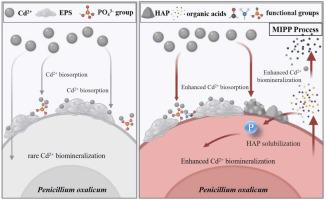当前位置:
X-MOL 学术
›
J. Hazard. Mater.
›
论文详情
Our official English website, www.x-mol.net, welcomes your feedback! (Note: you will need to create a separate account there.)
Penicillium oxalicum induced phosphate precipitation enhanced cadmium (Cd) immobilization by simultaneously accelerating Cd biosorption and biomineralization
Journal of Hazardous Materials ( IF 13.6 ) Pub Date : 2024-04-12 , DOI: 10.1016/j.jhazmat.2024.134306 Jiaru Yue , Ting Li , Jiang Tian , Fei Ge , Feng Li , Yun Liu , Dayi Zhang , Jingwei Li
Journal of Hazardous Materials ( IF 13.6 ) Pub Date : 2024-04-12 , DOI: 10.1016/j.jhazmat.2024.134306 Jiaru Yue , Ting Li , Jiang Tian , Fei Ge , Feng Li , Yun Liu , Dayi Zhang , Jingwei Li

|
Soil cadmium (Cd) is immobilized by the progressing biomineralization process as microbial induced phosphate precipitation (MIPP), which is regulated by phosphate (P) solubilizing microorganisms and P sources. However, little attention has been paid to the implications of Cd biosorption during MIPP. In this study, the newly isolated could immobilize 5.4–12.6 % of Cd, while the presence of hydroxyapatite (HAP) considerably enhanced Cd immobilization in and reached over 99 % Cd immobilization efficiency within 7 days. Compared to mono inoculation, MIPP dramatically boosted Cd biosorption and biomineralization efficiency by 71 % and 16 % after 96 h cultivation, respectively. preferred to absorbing Cd and reaching maximum Cd biosorption efficiency of 87.8 % in the presence of HAP. More surface groups in and HAP mineral involved adsorption which resulted in the formation of Cd-apatite [CaCd(PO)(OH)] via ion exchange. Intracellular S, secreted organic acids and soluble P via HAP solubilization complexed with Cd, progressively mineralized into Cd(PO)OH, Cd(HPO), CHCdO and CdS. These results suggested that Cd immobilization was enhanced simultaneously by the accelerated biosorption and biomineralization during induced P precipitation. Our findings revealed new mechanisms of Cd immobilization in MIPP process and offered clues for remediation practices at metal contaminated sites.
中文翻译:

草酸青霉诱导的磷酸盐沉淀通过同时加速镉的生物吸附和生物矿化来增强镉 (Cd) 的固定
土壤镉 (Cd) 通过微生物诱导的磷酸盐沉淀 (MIPP) 的形式被不断进行的生物矿化过程固定,该过程受磷酸盐 (P) 溶解微生物和磷源的调节。然而,很少有人关注 MIPP 过程中 Cd 生物吸附的影响。在这项研究中,新分离的Cd固定化率可以达到5.4-12.6%,而羟基磷灰石(HAP)的存在大大增强了Cd的固定化,并在7天内达到了99%以上的Cd固定化效率。与单一接种相比,培养 96 小时后,MIPP 显着提高了 Cd 生物吸附和生物矿化效率,分别提高了 71% 和 16%。在 HAP 存在的情况下,Cd 的吸收效率最高,可达 87.8%。 HAP 矿物中的更多表面基团涉及吸附,从而通过离子交换形成 Cd-磷灰石 [CaCd(PO)(OH)]。细胞内的 S、分泌的有机酸和可溶性 P 通过 HAP 增溶与 Cd 络合,逐渐矿化为 Cd(PO)OH、Cd(HPO)、CHCdO 和 CdS。这些结果表明,在诱导磷沉淀过程中,加速的生物吸附和生物矿化同时增强了镉的固定化。我们的研究结果揭示了 MIPP 过程中镉固定的新机制,并为金属污染场地的修复实践提供了线索。
更新日期:2024-04-12
中文翻译:

草酸青霉诱导的磷酸盐沉淀通过同时加速镉的生物吸附和生物矿化来增强镉 (Cd) 的固定
土壤镉 (Cd) 通过微生物诱导的磷酸盐沉淀 (MIPP) 的形式被不断进行的生物矿化过程固定,该过程受磷酸盐 (P) 溶解微生物和磷源的调节。然而,很少有人关注 MIPP 过程中 Cd 生物吸附的影响。在这项研究中,新分离的Cd固定化率可以达到5.4-12.6%,而羟基磷灰石(HAP)的存在大大增强了Cd的固定化,并在7天内达到了99%以上的Cd固定化效率。与单一接种相比,培养 96 小时后,MIPP 显着提高了 Cd 生物吸附和生物矿化效率,分别提高了 71% 和 16%。在 HAP 存在的情况下,Cd 的吸收效率最高,可达 87.8%。 HAP 矿物中的更多表面基团涉及吸附,从而通过离子交换形成 Cd-磷灰石 [CaCd(PO)(OH)]。细胞内的 S、分泌的有机酸和可溶性 P 通过 HAP 增溶与 Cd 络合,逐渐矿化为 Cd(PO)OH、Cd(HPO)、CHCdO 和 CdS。这些结果表明,在诱导磷沉淀过程中,加速的生物吸附和生物矿化同时增强了镉的固定化。我们的研究结果揭示了 MIPP 过程中镉固定的新机制,并为金属污染场地的修复实践提供了线索。



























 京公网安备 11010802027423号
京公网安备 11010802027423号